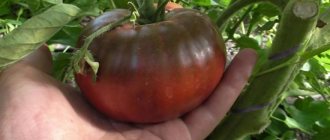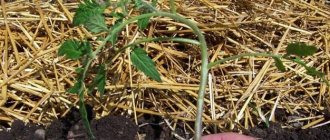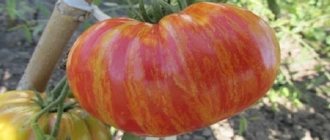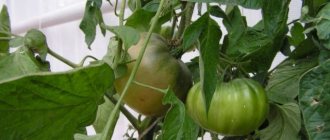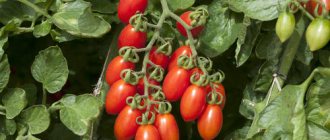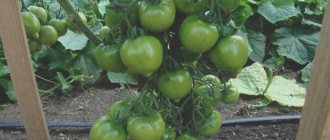Black bison is a beautiful colored tomato that is a favorite of many gardeners. The violet-purple color, large size, and abundance of fruits attract attention.
| Height | Landing location | Ripening time | Fruit color | Fruit size | Origin | Fruit shape |
| Tall | Greenhouse, Open ground | Mid-early | Black | Large | Variety | Flat-round |
Description of the tomato variety Black Bison
Black bison tomatoes, according to the description of the originators and reviews from gardeners, are representatives of indeterminate mid-early varieties. The plant is tall, its height is more than 180 cm. The tomato is distinguished by powerful light green stems with a large number of nodes.
The side shoots do not stretch much. The leaves are large, tomato-type, dark green. When planting, it should be taken into account that any shading leads to the development of late blight and other diseases, so they are planted according to a 50x50 cm pattern.
Fruiting of the Black Bison tomato, according to characteristics and reviews, begins 108-115 days after sowing the seeds for seedlings. The peduncles are powerful, each of them has 5-6 large flowers, on which ovaries are subsequently formed.
At first the fruits are juicy green, by the time they are fully ripe they become dark purple, almost purple-brown, with a shiny surface. Dark stains are clearly visible in the area of the stalk. Several chambers can be seen on the cut, but there are few seeds.
The shape of the tomatoes is rounded and flattened, with clear ribbing on the fruits. Black bison tomatoes have thin and delicate skin. The tomatoes are large, with an average weight of 200-250 g. If cultivation techniques are followed, they can reach a weight of 550 g.
Fruiting is prolonged; on one plant you can simultaneously contemplate small ovaries and ripe fruits. The ovaries are located along the length of the entire stem, so in unheated greenhouses, all tomatoes, according to gardeners, do not have time to ripen.
Important! Fruits at the stage of blange ripeness ripen well in boxes, while the beneficial and taste properties are completely preserved
.
Soil preparation
Let's consider two options for preparing the soil: if the seedlings are planted in a greenhouse or in open ground.
Earth in a greenhouse
Preparations begin in the fall:
- After harvesting, clear the ground of leaves and weeds. Remove the top layer of soil, approximately 7 cm, as there is a large accumulation of fungi and pests there;
- lay a layer of sawdust, straw, pine needles 5 cm thick. They will absorb excess nitrogen and loosen the soil. You can add lime on top to normalize acidity;
- lay a layer of manure 10 cm thick. It will provide nutrition and warmth;
- lay renewed greenhouse soil on top;
- To enrich the land with nitrogen, it is worth sowing any of the crops: buckwheat, wheat, mustard, clover. In the spring, during the flowering period, dig up the soil along with the grown grass;
- in early spring, before planting seedlings, disinfect the soil and walls of the greenhouse to destroy bacteria;
- 2 weeks before planting seedlings, loosen the soil, remove weeds, and apply fertilizer.
Open ground
When choosing a place to plant seedlings, it is worth considering the principle of crop rotation. A plot where only tomatoes are grown year after year will become infested with pests common to tomatoes. It is better to plant sprouts after onions, cabbage, zucchini, carrots, and alfalfa.
Soil preparation begins in the fall, after harvesting:
- clear the ground of weeds;
- loosen to a depth of 8–12 cm with partial soil wrapping to cut off the roots of weeds and destroy insect pests;
- if the soil acidity is high, you need to add lime - it will lower the acidity level;
- add organic fertilizers so that by spring they have time to dissolve in the soil;
- a week before planting seedlings, add mineral fertilizers to the soil;
- two days before planting, disinfect the soil and add wood ash.
Taste qualities of Black Bison tomatoes
The fruits of the Black Bison variety, according to consumer reviews, have a bright tomato taste. The pulp is juicy, with fruity notes in the aftertaste.
Culinary use:
- For preparing fresh salads and slices.
- Juicy tomatoes are an excellent raw material for preparing tomato juice with pulp. It has an unusual dark color and rich taste.
- Ketchup is prepared from the fruits and added to various preparations for the winter in chopped or ground form.
Comment! According to consumer reviews, the fruits as a whole are not suitable for preservation, since they have thin skin, and heat treatment leads to cracking.
Farmer reviews
tomato variety is in demand among gardeners, and mostly has positive reviews .
Here are some of them: Vladimir (Kazan): I was interested in the characteristics and description of the Black Bison variety, I really liked the photos of it on the bushes and in cut form.
In the spring I planted 100 seeds, having previously disinfected and hardened them. I grew tomatoes in a greenhouse, regularly watered and fertilized. The tomatoes ripened in 3 months. The fruits are beautiful, tasty and juicy, the whole family liked them. I note that the plants are quite difficult to care for, as they are demanding of heat, watering and fertilizers. Overall, I am pleased with this variety and will continue to grow it. Nadezhda (Ural): I really liked the taste, no acid, but the shoulders remain with dark green stains and are hard; in the Urals they ripen in August-September.
Alena (Kostroma): A tall, powerful bush, but my yield was not very high. The tomato is delicious, rich tomato taste with an unusual aftertaste, very juicy. Prone to cracking, I really didn't like it.
Pros and cons of the Black Buffalo tomato variety
To understand whether to plant a new variety of tomatoes on a plot or not, you need more than just a description. You will need characteristics of the Black Buffalo tomato, and specifically, the positive and negative aspects of the variety.
According to reviews from those who have been growing the Black Buffalo tomato for a long time, the variety has many advantages:
- The exotic colors of the fruit make not only the plant itself attractive, but also cutting the vegetable in a dish is also a delight.
- The unusual spicy taste will attract the most demanding consumers.
- The Black Bison variety is distinguished by its high yield, as people who have been growing tomatoes for more than one year write about in reviews.
- Possibility of growing crops in open and protected ground.
- Plants are especially valued by farmers who have heated greenhouses. You can grow Black Buffalo tomatoes in them for 12 months.
- Tomatoes are practically not affected by fungal diseases, as they have excellent immunity given by their originators. But prevention should not be neglected.
Despite the large number of positive characteristics, the Black Buffalo tomato still has disadvantages; gardeners often write about them in reviews:
- Long ripening period.
- Plants should not be left unattended for a long time.
- During care, you must follow the agrotechnical standards specific to the Black Bison variety.
- Low transportability due to the thin and delicate skin, which is why summer residents who need to transport their crops from their dachas pick the fruits when they are ripe.
Origin of the variety
In 1937, the American breeder Luther Burbank accidentally noticed a small tomato bush, whose stem stopped growing above the third cluster and the fruits were ripening. The breeder isolated this feature into a separate variety, calling it Bison for its stockiness.
In the USSR, breeders took the seeds as a basis and developed domestic varieties adapted to our climatic zones: “Yellow Bison”, “Orange Bison”, “Pink Bison”, “Black Bison” and the F1 hybrid “Crimson Bison”.
Growing
Black bison is a hybrid with a medium-early ripening period. As a rule, it is grown in seedlings. By the time of planting, the seedlings should be about 40-50 cm in height.
Growing seedlings
Growing seedlings begins in mid-March. For this you can only use store-bought seeds. They need to be prepared for sowing in order to avoid many problems in the future when growing large-fruited tomatoes.
Seed preparation
First, put the seeds in salted water (for 1 tablespoon of water - 1 tablespoon of salt). In such a solution, empty, non-viable seeds will float, and good ones will end up at the bottom.
To disinfect, Black Bison tomato seeds are placed in a pink solution of potassium permanganate for 30 minutes, then washed with clean water.
To speed up germination you will need Epin-Extra. For 100 g of water, 1-2 drops of growth stimulator are enough. Seeds, tied in a piece of gauze, are kept in the solution for 18 hours.
Preparing containers and soil
To grow seedlings, as gardeners write in reviews, they use a common box or separate cassettes, if they do not involve picking. If the container is new, then it is simply washed with a hot soapy solution, then rinsed with clean water. Containers that were used previously should be doused with boiling water with the addition of several crystals of potassium permanganate.
Seeds are sown in fertile soil. You can use ready-made soil or create the soil yourself. To do this, take garden soil and add compost or humus. An essential component is wood ash, which is added to enrich the soil with nutrients.
Any soil can contain disease spores. In order for the seedlings to grow healthy, you need to pour boiling water with potassium permanganate into the soil. Cover the top of the containers with film to achieve a better effect.
Attention! It is necessary to prepare the soil in advance so that by the time the seeds are sowed, beneficial microflora has time to develop.
Sowing seeds
Black bison tomato seeds, when planted in boxes, are sown at a distance of at least 5 cm. Planting depth is 1.5 cm. According to gardeners, this is the optimal scheme for a hybrid.
When sowing seeds in separate containers, place 1-2 seeds in a hole. Then they leave the strongest sprout. After sowing, the soil is lightly patted down and covered with film or glass on top.
The containers are placed in a warm, well-lit window. Seeds germinate quickly at a temperature of 20-23 degrees. As soon as green hooks appear, the cover is removed. The temperature is reduced to 18 degrees, and lighting is added so that the seedlings do not stretch.
Attention! Daylight hours should last at least 12 hours. If necessary, you can install backlighting.
Further care of seedlings comes down to timely watering. To fertilize at this stage, use a pink solution of potassium permanganate or wood ash extract.
After 2-3 true leaves appear, picking is performed. If you plan to grow Black Bison tomatoes in open ground, then 14 days before planting, the plants must be hardened off and accustomed to new conditions.
Landing rules
According to reviews from gardeners and photos sent by them, you can grow the Black Bison tomato in protected and open ground.
Features of planting in a greenhouse:
- The soil needs to be prepared in the fall. To do this, you need to remove the top layer, in which fungal spores may remain. Then put straw and sawdust. On top is garden soil mixed with humus.
- As gardeners write in reviews, they sow buckwheat and mustard seeds in the fall to enrich the soil.
- In spring, the soil is dug up along with the remains of sown plants. Be sure to add wood ash as a preventative against blackleg.
- The soil in the greenhouse for planting Black Bison tomatoes is spilled with hot water and potassium permanganate.
- The holes are made according to the 50x50 cm pattern.
- Fill the hole with water and then plant the seedlings.
- After planting, water again.
Planting in open ground, according to reviews from summer residents, is not much different, except for the timing and layout. On the beds, seedlings are planted at a distance of 45 cm. Seedlings can be placed in the greenhouse in early May. If it is heated, then earlier. Planting in ordinary beds is planned after the soil has warmed to a sufficient depth and the threat of a return of spring frosts has disappeared.
Watering and fertilizing
Black bison tomatoes need to be watered generously every 5-6 days. Stagnation of water should not be allowed. For irrigation it is better to use settled water.
Organic fertilizers are used for fertilizing if gardeners are interested in obtaining environmentally friendly products. You can feed plants both at the root and at the leaves. The Black Bison hybrid, according to gardeners, responds well to feeding with iodine. 7 drops per bucket of water is enough.
Important! Root feeding is carried out on pre-watered soil.
Pinching and tying
All leaves located below the first inflorescence, as well as stepsons, must be removed in a timely manner. This will give the tomatoes the strength to form a decent harvest.
A tall plant needs staking. This procedure is carried out from the moment of planting the seedlings and throughout the growing season.
Formation
As summer residents write in reviews, it is better to form Black Bison tomato bushes into two stems, in this case the yield will be maximum. The plants will receive enough nutrition, the fruits will have time to ripen.
Protection from diseases and pests
Tomato varieties have excellent immunity, although, according to gardeners, some problems still occur.
Due to their thin skin and sweetish taste, the fruits often become prey for insects, in particular slugs. They will have to be removed manually or set up in traps.
Among the diseases, reviews mention late blight. This disease appears if tomatoes that are less resistant to the disease are planted nearby. Therefore, there is no need to neglect preventive measures.
Planting region and yield
Tomatoes are heat-loving plants. Growing conditions in open ground are not suitable for them: low air temperature, climate variability. Growth and maturation occurs in protected soil.
The black Bison tomato is grown in film greenhouses, so the region of cultivation does not play a special role. In areas with a stable, warm, mild climate, the crop is grown in open ground. If the greenhouse is heated, tomatoes are cultivated all year round.
The growing season is 165–175 days. Harvesting from one bush is from 4 to 6 kg.
To increase productivity, it is recommended to form the bush into two trunks, no more. In order for the tomatoes to gain a large shape after the 6th ovary, the trunk is pinched.
Sowing seeds for seedlings
It is better to sow seeds of this variety in late March or early April. If you are going to grow a large number of bushes, you can sow them in large boxes, and if you have a couple of bushes, then peat tablets will be enough.
To create such an earthen mixture, you will need to combine peat, garden soil, humus and wood ash (2:1:1:1). You can add a small amount of potassium fertilizer and superphosphate.
The prepared earthen mixture must be sifted and steamed in a double boiler. This will help you get rid of bacteria, weed seeds and fungal spores. The soil is loose, moisture-absorbing and breathable.
Planted seedlings should be placed on a south-facing window during the day, and simply left on the windowsill at night. The temperature during the day should be 22 °C, and at night – 18 °C.
From the moment of sowing, you can water the seedlings once or twice. No additional feeding is needed. Out of eight sifted peat tablets, only three can break through.
Transplanting tomatoes into open ground
The seedlings are transferred to open ground after the soil warms up to 16°C and night temperatures do not fall below 10°C. In any case, this should not be done before the 10th of May (in the middle zone), as there is a high probability of night frosts. At first, the bed can be covered with film for safety net.
Tomatoes are planted according to the following scheme:
- the interval in the rows between seedlings is 40-45 cm;
- the distance between rows is 50-60 cm.
The depth of the hole is 25 cm. Before planting the seedlings, peat and wood ash (1 cup each) are poured into the holes.
When planting tomatoes in a greenhouse, the same conditions are met, but the timing of transfer of seedlings is determined differently. You need to focus on the degree of soil warming. The indicator should not fall below 15°, otherwise the root system will not develop normally, which will delay the harvest time. You should also avoid large temperature changes, which is typical for the month of March - April, when the daytime temperature reaches 30° and above, and the night temperature drops to 12-14°.
Planting and watering
In the greenhouse, the beds are made in the form of a mound 30 cm high and 60–80 cm wide. A series of holes are made at a distance of at least 45 cm from each other. Immediately install supports for gartering plants. The inter-row distance is 55–60 cm. Care should be taken to provide the plants with an additional light source.
Before planting in open ground, seedlings are hardened off. For 2 weeks, the sprouts are taken out into the open air at a temperature not lower than 15°C, each time increasing the time spent outside. Seedlings are planted in open ground in the evening or in cloudy weather. The selected area should be in a sunny, not damp place, preferably on a slight hill.
The technique for planting sprouts in beds in open ground is the same as in a greenhouse.
Attention! It is better to plant seedlings in a checkerboard pattern. This way the tomatoes will receive the optimal amount of light and heat, and the bushes will be well ventilated.
During the growth of the bush, be sure to remove stepsons and lower leaves to reduce the occurrence of fungal diseases. Tie the bunches with fruits so that the tomatoes do not touch the ground. Black Bison, like all dark-fruited crops, has very thin skin - this attracts the attention of pests.
During plant growth, watering should be moderate. During the period of fruit ripening - abundant. It is better to water in the evening, at the root, avoiding water getting on the leaves.
For productive growth, tomatoes need nitrogen, potassium, phosphorus:
- lack of nitrogen inhibits growth. The plant brightens, the leaves turn yellow and fall off;
- loss of potassium causes leaves to curl at the edges and brown-yellow spots form;
- lack of phosphorus stops the growth of the plant, the stem and shoots become bluish, the leaves turn gray.
The task will be to choose the right fertilizer, which is applied during or alternating with watering the tomatoes.
general characteristics
Bison Black is a mid-late variety; the tomatoes are heat-loving and prefer a lot of light. Productivity greatly depends on agricultural technology and the conditions in which the tomato bush is located.
Description of fruits and bushes
The bush is indeterminate and can reach 3 m in height. Usually it is limited in height when it reaches 180-200 cm for ease of care.
The stem is powerful and branched. The leaves are medium-sized, from green to dark green.
Black Buffalo tomatoes, despite the name of the variety, have a rather purple tint. In size they reach 3 00 g. The shape is flat, round, without obvious ribbing.
The taste of the fruit is described as:
- sweet;
- saturated;
- no acid;
- with a strong aftertaste.
Productivity
The variety is characterized by a high level of productivity: up to 6 kg of tomatoes per bush under ideal growing conditions. When planting 4 bushes per square meter in closed ground, the yield will be up to 24 kg.
The yield is significantly reduced when tomatoes are planted in open ground and amounts to about 3 kg per bush.
How are the fruits used?
The fruits are used to prepare salads, soups, sauces and juices. Freezing is possible, but this will destroy the structure of the tomato pulp.
They are not suitable for pickling or pickling in their entirety due to their tendency to crack. For the same reason, long-term storage of the crop becomes impossible.
Resistance to diseases and pests
The variety is resistant to most diseases
The variety is resistant to most diseases, but is sometimes affected by late blight.
Of the pests, you should be wary of those who feed directly on the fruits: they have very thin skin.
Advantages and disadvantages
Let us briefly outline the positive qualities of the Sugar Bison variety, according to experienced gardeners:
- high germination of seed material;
- quantitative yield indicators are high;
- tomatoes are very tasty and ripen at the same time;
- the ability to preserve whole fruits;
- drought resistance;
- ability for long-term transportation;
- good resistance to damage;
- versatility of application.
The ripening fruit of the Sugar Bison variety.
Existing disadvantages of the Sugar Bison variety: the variety is best grown in greenhouses, high requirements for watering and lighting, sensitivity to rot.
The Sugar Bison variety has good immunity to major diseases, except brown rot. Infected fruits must be removed and watering reduced.
The variety is most often attacked by whiteflies in the greenhouse. In open ridges, thrips and nightshade miners eat the bushes. Preventative spraying against them is carried out with chemicals.
We invite you to join our group on VKontakte or Odnoklassniki, where new articles are published, as well as news for gardeners and livestock farmers.
Care
The bushes require moderate and regular watering until the fruits begin to appear. At this moment, watering should become more abundant, and the soil should also be loosened frequently so that it is saturated with air and the water does not stagnate. Mineral fertilizers are also required; you can purchase any balanced complexes without making anything yourself. This is also one of the advantages of this variety in terms of care.
The bushes are formed into 2 trunks; pinching is mandatory to maintain the plant’s immunity.
Since this variety is very heat-loving, you will need to make sure that it has a lot of light. The taste of the fruit will depend on how well the planting site is lit. The lack of light and sun makes not only the color less saturated, but also the taste more bland. Often fruits that have not received enough light may be yellow.
We can talk about harvesting 4 or 4.5 months after the seedlings were made. That is, tomatoes will be ripe at the end of July and beginning of August.
Description of the plant
The plant is tall, can reach 180 cm in height, the bush is powerful, needs tying up and removing the stepsons; when installing the support, make sure it is strong and reliable.
To increase productivity, form a stem into 1-2 trunks. To make the fruits larger, you should pinch the plants after 5-6 ovaries have formed. Remember to gradually but promptly remove the lower leaves of plants to prevent them from consuming nutrients.
Common mistakes when growing varieties
The most common mistakes are:
- Ignoring plant nutrition. Fertilizers play a big role for the variety, since they significantly affect the formation and ripening of fruits. Without fertilizing, there may be no harvest at all.
- Watering seedlings from a watering can. The first shoots are so fragile that a stream of water can destroy them.
- Planting plants outside greenhouses. This is only possible in warm climates and long daylight hours. Otherwise, the plant may not produce a harvest.
- Garter the stem only. The fruits are very heavy, so it is recommended to tie up the plant’s clusters to prevent them from breaking off. It is also recommended to tie up the side stems.
